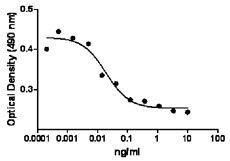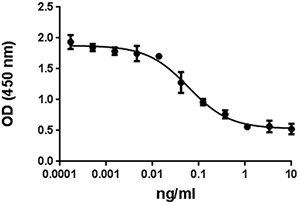- Regulatory Status
- RUO
- Other Names
- Luteotropin, PRL
- Ave. Rating
- Submit a Review
- Product Citations
- publications

-

Nb2-11 cell proliferation induced by human Prolactin.
| Cat # | Size | Price | Save |
|---|---|---|---|
| 559004 | 25 µg | ¥29,260 | |
| 559006 | 100 µg | ¥66,670 |
Select size of product is eligible for a 40% discount! Promotion valid until December 31, 2024. Exclusions apply. To view full promotion terms and conditions or to contact your local BioLegend representative to receive a quote, visit our webpage.
Prolactin, also known as luteotropin, is a hormone that is secreted by the pituitary gland and is best known for its role in enabling female mammals to produce milk. However, prolactin has also been shown to play essential roles in the regulation of immune functions, pancreatic development, angiogenesis, reproduction, osmoregulation, and metabolism. Besides the pituitary origin, prolactin is found in other tissues and cells such as adipocytes, immune cells, skin, prostate, brain, and decidua. This hormone is produced in increasing amounts during pregnancy and suckling. It acts on the mammary gland by initiating and maintaining lactation in the postpartum period. Epidemiological studies have demonstrated that circulating high levels of prolactin increase the risk of breast cancer. Prolactin may promote mammary tumor initiation via the JAK2/STAT5 signaling pathway. Human prolactin has a 60% amino acid sequence homology with its murine counterpart. In a knockout animal study, it was shown that female mice lacking the expression of prolactin were infertile, but does not prevent them from manifesting spontaneous maternal behaviors. In addition, these animals show no sign of alterations in myelopoiesis and lymphopoiesis, suggesting that prolactin may not play an indispensable role in lymphocyte development and myeloid differentiation.
Product DetailsProduct Details
- Source
- Human Prolactin, amino acids (Leu29-Cys227) (Accession# NP_000939.1), with an additional Met at the N-terminus, was expressed in E. coli.
- Molecular Mass
- The 200 amino acid recombinant protein has a predicted molecular mass of approximately 23 kD. The protein migrates approximately at 25 kD in DTT-reducing conditions by SDS-PAGE. The predicted N-terminal amino acid is Met.
- Purity
- >95%, as determined by Coomassie stained SDS-PAGE.
- Formulation
- 0.22 µm filtered protein solution is in PBS.
- Endotoxin Level
- Less than 0.1 EU per µg of protein as determined by the LAL method.
- Concentration
- 10 and 25 µg sizes are bottled at 200 µg/mL. 100 µg size and larger sizes are lot-specific and bottled at the concentration indicated on the vial. To obtain lot-specific concentration and expiration, please enter the lot number in our Certificate of Analysis online tool.
- Storage & Handling
- Unopened vial can be stored between 2°C and 8°C for up to 2 weeks, at -20°C for up to six months, or at -70°C or colder until the expiration date. For maximum results, quick spin vial prior to opening. The protein can be aliquoted and stored at -20°C or colder. Stock solutions can also be prepared at 50 - 100 µg/mL in appropriate sterile buffer, carrier protein such as 0.2 - 1% BSA or HSA can be added when preparing the stock solution. Aliquots can be stored between 2°C and 8°C for up to one week and stored at -20°C or colder for up to 3 months. Avoid repeated freeze/thaw cycles.
- Activity
- Human Prolactin induces proliferation of Nb2-11 rat lymphoma cells in a dose dependent manner. The ED50 is 0.03 — 0.15 ng/mL.
- Application
-
Bioassay
- Application Notes
-
The proliferation assays were performed in a serum free medium.
BioLegend carrier-free recombinant proteins provided in liquid format are shipped on blue-ice. Our comparison testing data indicates that when handled and stored as recommended, the liquid format has equal or better stability and shelf-life compared to commercially available lyophilized proteins after reconstitution. Our liquid proteins are verified in-house to maintain activity after shipping on blue ice and are backed by our 100% satisfaction guarantee. If you have any concerns, contact us at tech@biolegend.com.
Antigen Details
- Structure
- Monomer.
- Distribution
- Anterior pituitary gland (lactotrophs), immune cells, the brain, decidua, adipocytes, and cholangeocytes.
- Function
- Prolactin plays a role in pregnancy, lactogenic activity, and breast and prostate cancer development. The secretion of prolactin is negative controlled by hypothalamic dopamine. The prolactin releasing factors include the thyrotropin-releasing hormone, vasoactive intestinal polypeptide, vasopressin, serotonin, angiotensin II, and oxytocin.
- Interaction
- Mammary epithelial cells.
- Ligand/Receptor
- PRLR (prolactin receptor)
- Bioactivity
- Human Prolactin induces proliferation of MCF7 cells.
- Cell Type
- Hematopoietic stem and progenitors
- Biology Area
- Stem Cells
- Molecular Family
- Growth Factors, Cytokines/Chemokines
- Antigen References
-
1. Acosta JJ, et al. 2003. Mol. Endocrinol. 17:2268.
2. Ben-Jonathan N, et al. 1996. Endocr. Rev. 17:639.
3. Ben-Jonathan N, et al. 2008. Endocrine Rev. 29:1.
4. Bernichtein S, et al. 2010. J. Endocrinol. 206:1.
5. Correale, J. 2014. J. Neuroimmunol. 269:76.
6. Horseman ND, et al. 1997. EMBO J. 16:6926.
7. Kennett JE and McKee DT. 2012. J. Neuroendocrinol. 24:403. - Gene ID
- 5617 View all products for this Gene ID
- UniProt
- View information about Prolactin on UniProt.org
Related FAQs
- Why choose BioLegend recombinant proteins?
-
• Each lot of product is quality-tested for bioactivity as indicated on the data sheet.
• Greater than 95% Purity or higher, tested on every lot of product.
• 100% Satisfaction Guarantee for quality performance, stability, and consistency.
• Ready-to-use liquid format saves time and reduces challenges associated with reconstitution.
• Bulk and customization available. Contact us.
• Learn more about our Recombinant Proteins. - How does the activity of your recombinant proteins compare to competitors?
-
We quality control each and every lot of recombinant protein. Not only do we check its bioactivity, but we also compare it against other commercially available recombinant proteins. We make sure each recombinant protein’s activity is at least as good as or better than the competition’s. In order to provide you with the best possible product, we ensure that our testing process is rigorous and thorough. If you’re curious and eager to make the switch to BioLegend recombinants, contact your sales representative today!
- What is the specific activity or ED50 of my recombinant protein?
-
The specific activity range of the protein is indicated on the product datasheets. Because the exact activity values on a per unit basis can largely fluctuate depending on a number of factors, including the nature of the assay, cell density, age of cells/passage number, culture media used, and end user technique, the specific activity is best defined as a range and we guarantee the specific activity of all our lots will be within the range indicated on the datasheet. Please note this only applies to recombinants labeled for use in bioassays. ELISA standard recombinant proteins are not recommended for bioassay usage as they are not tested for these applications.
- Have your recombinants been tested for stability?
-
Our testing shows that the recombinant proteins are able to withstand room temperature for a week without losing activity. In addition the recombinant proteins were also found to withstand four cycles of freeze and thaw without losing activity.
- Does specific activity of a recombinant protein vary between lots?
-
Specific activity will vary for each lot and for the type of experiment that is done to validate it, but all passed lots will have activity within the established ED50 range for the product and we guarantee that our products will have lot-to-lot consistency. Please conduct an experiment-specific validation to find the optimal ED50 for your system.
- How do you convert activity as an ED50 in ng/ml to a specific activity in Units/mg?
-
Use formula Specific activity (Units/mg) = 10^6/ ED50 (ng/mL)









_122109.jpg)




Follow Us